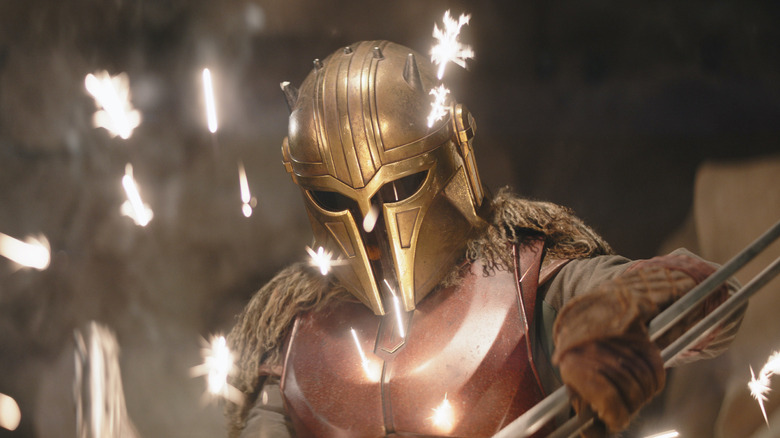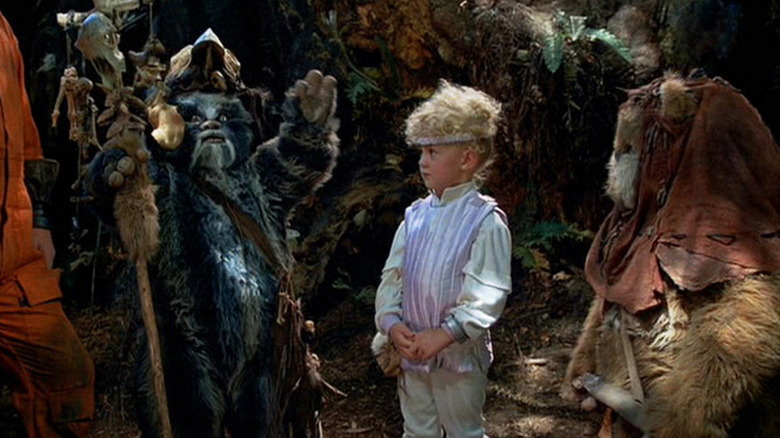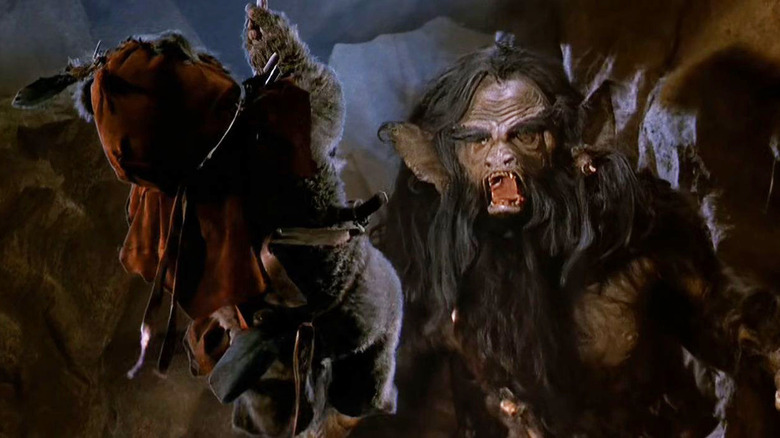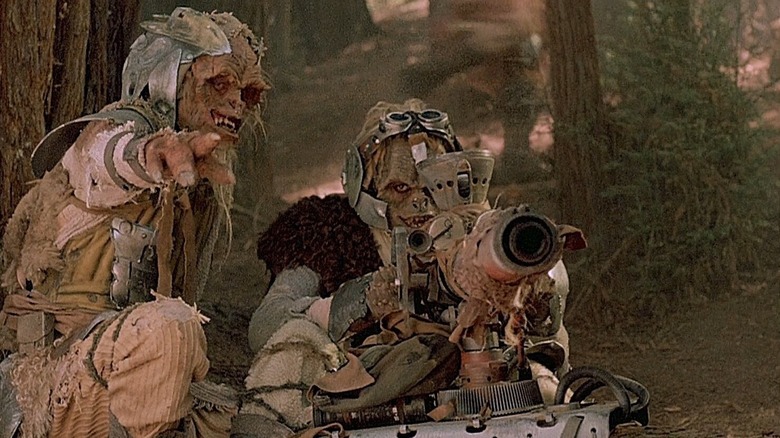The Mandalorian Is Starting To Remind Me Of The Ewok Movies (And I'm Not Mad)
This article contains spoilers for "The Mandalorian."
Even before the credits rolled on "The Mandalorian" season 3's fourth episode, "Chapter 20: The Foundling," I had a strong inkling of who'd worked on it. Much like he did when he called the shots on season 2's "The Siege," co-star Carl Weathers stepped behind the camera this week to deliver some muscular (if noticeably Volume-y) action in a tightly-wound package. Similarly, the whole heroes-on-a-rescue-mission storyline felt very much like a Jon Favreau special. And, of course, who else but Favreau's writing partner in crime here, Dave Filoni, would combine themes about the duality of nature with an Order 66 flashback in the same episode?
The longer I dwelled on it, though, the more I realized "The Foundling" brought something else to my mind: the Ewok movies. Yes, those Ewok movies.
For those not familiar (i.e. for all you younglings out there): "Caravan of Courage: An Ewok Adventure" and its sequel, "Ewoks: The Battle for Endor," aired as TV movies on ABC in 1984 and 1985, but also received international theatrical releases. Despite being co-written and executive produced by George Lucas, the movies were excluded from the official "Star Wars" canon after Disney bought Lucasfilm in 2012. Some would just as soon pretend these films didn't exist, but for me, the Ewok features offer many of the same weird, pulpy delights as other '80s fantasy adventures. More to the point, there's a surprising amount of overlap between the Ewok movies and what's happening on "The Mandalorian" in season 3, and I for one am perfectly fine with that.
Found(ling) families
"The Foundling" sees Grogu being indoctrinated introduced as a foundling to the Children of the Watch's ranks, giving him a chance to show off some of those nifty Jedi skills he picked up training with Luke Skywalker on "The Book of Boba Fett." The idea of found family has always been central to "The Mandalorian" and its namesake's story, yet it's also been a core element of animated "Star Wars" shows like "Star Wars Rebels" and "The Bad Batch." If anything, this only further supports my previous argument that "The Mandalorian" operates as a bridge of sorts between the live-action and animated sides of the franchise. (I hope everyone is imagining me grinning like I'm Timothy Dalton posing in front of my own portrait right now.)
The concept of found family is equally essential to both of the Ewok movies. In "Caravan of Courage: An Ewok Adventure," the furry warriors of Endor (including Wicket W. Warrick — yes, that is his full name) take in and care for young Cindel (Aubree Miller) and her older brother Mace (Eric Walker), a pair of human travelers who were separated from their parents after being stranded on the forest moon. "Ewoks: The Battle for Endor" goes a step further, introducing Wilford Brimley as Noa Briqualon, a gruff old fellow who's been stuck on the moon for years. Sure enough, just as when Din Djarin met Grogu, it doesn't take much for the plucky Cindel and Wicket to melt the grumpy codger's heart.
It just goes to show: the Ewok movies were ahead of the curve when it comes to "Star Wars" tapping into that sweet, sweet "Lone Wolf and Cub" formula.
Epic rescue quests
Whereas a show like "Andor" falls more on the grounded sci-fi side of the sci-fi/fantasy equation, "The Mandalorian" takes place in a universe overflowing with fantastical and frequently gigantic creatures (be they aquatic, aerial, or snow-based). Such is also the case with both of the Ewok films. "Caravan of Courage: An Ewok Adventure," in particular, features the Gorax, an enormous, dark-furred resident of Endor armed with fangs, sharp claws, and eyebrows bushy enough they would intimidate Martin Scorsese. "Ewoks: The Battle for Endor" likewise pits its heroes against the Sanyassan Marauders, an ape-like group of reptiloids who hail from the planet Sanyassa and have more than a whiff of the Orcs of Middle-earth to them. (In case you thought "The Mines of Mandalore" was the first time "Star Wars" has gone full "Lord of the Rings.")
Of the two films, it's "Caravan of Courage" that bears the strongest resemblance to "The Foundling" in terms of its plot. Most of the movie centers on the Ewoks helping Cindel and Mace rescue their parents from the Gorax, pitting them against a hodgepodge of dangers as they make the epic journey to the creature's lair. "The Battle for Endor" isn't too far away from them, though, as the film sees many of the Ewoks being attacked and taken captive by the Marauders (leaving it to Cindel and Wicket to save the day). Both movies also have an advantage over "The Mandalorian," having shot on location in California's Redwood National Park. It affords them a scale and the sense of characters actually traveling vast distances that is, for the time being, still really difficult to replicate filming with the Volume tech.
The truth behind the legend
Perhaps more than any other "Star Wars" projects, the Ewok movies lean heavily into the idea that magic — not the Force, but proper magic — is a real thing that exists in a galaxy far, far away. "Caravan of Courage: An Ewok Adventure" features enchanted sticks and lakes that trap you in their reflective surface if you touch them, whereas "Ewoks: The Battle for Endor" has Charal (Siân Phillips), a malevolent sorceress with a ring that allows her to turn into a raven. At the same time, "The Battle for Endor" confirms that what some believe to be "magic" is really just technology. Specifically, the Marauders and Charal are on the hunt for the mystical artifact they dub "the power," unaware what they're actually looking for is a basic energy cell for a star cruiser.
By comparison, "The Mandalorian" season 3 continues to suggest there's far more to the Children of the Watch's prophecies about a new age of Mandalore than meets the eye. Din Djarin has already discovered that Mandalore isn't "cursed" as the others believed and may yet be reclaimable despite the devastation the Empire unleashed upon it during the Night of a Thousand Tears. Meanwhile, the level-headed Bo-Katan Kryze is (thankfully?) the only one who's aware there's a living, breathing Mythosaur residing in the Living Waters of the planet's mines and is trying to find a way to break this news to the members of her extremely religious tribe. This motif of uncovering the scientific facts behind the legends of Mandalore looks to become all the more important heading into the second half of this season.
New episodes of "The Mandalorian" premiere Wednesdays on Disney+.



